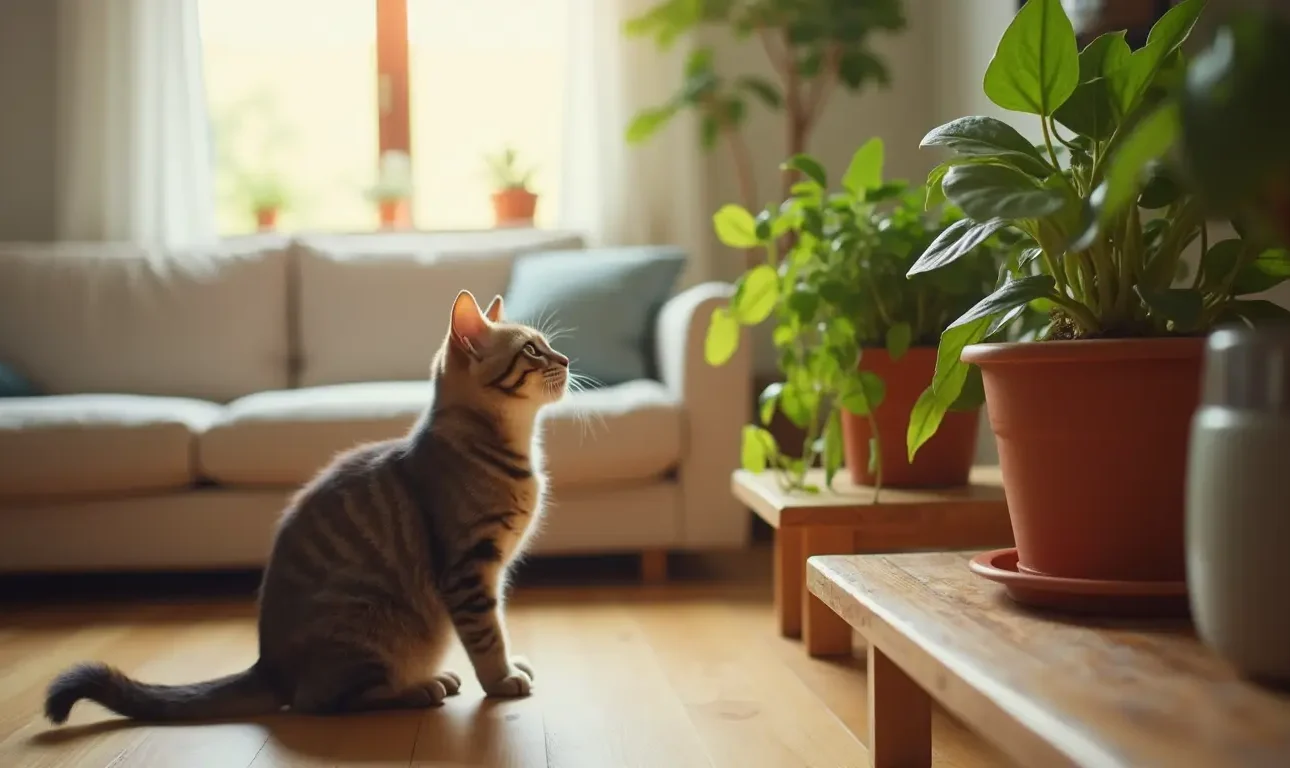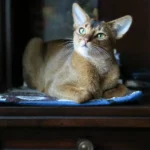ZZ plants (Zamioculcas zamiifolia) have become a favorite among plant enthusiasts due to their striking appearance and resilience. Known for their glossy, dark green leaves and low-maintenance care, ZZ plants are perfect for beginners or anyone looking to add greenery to their home without a lot of hassle. Additionally, they’re praised for their air-purifying qualities, making them a great choice for indoor spaces.
However, if you’re a pet owner, especially a cat lover, it’s crucial to be mindful of the plants you bring into your home. Many common houseplants can be toxic to pets, and even the most harmless-looking plants can pose a serious health risk to cats if ingested. That’s why it’s essential to know which plants are safe for your furry friends.
So, the big question remains: Are ZZ plants toxic to cats? Let’s dive into the facts and explore what you need to know to ensure your cat’s safety around this popular houseplant.
Table of Contents
What Are ZZ Plants?
Definition and Characteristics of ZZ Plants
The ZZ plant (Zamioculcas zamiifolia) is a popular evergreen perennial native to eastern Africa, particularly in regions like Kenya and Tanzania. Known for its striking glossy, dark green leaves and waxy texture, the ZZ plant is often admired for its sleek, modern appearance. The plant’s unique growth habit features long, arching stems that can grow up to 3 feet in height. Its thick, fleshy stems store water, allowing the ZZ plant to withstand periods of drought, making it an ideal choice for busy plant owners or beginners.
Caring for a ZZ plant is relatively easy, as it thrives in low light conditions and can tolerate neglect. It only requires occasional watering, and it’s not very sensitive to temperature changes, making it a great option for a variety of indoor environments. However, it’s important to avoid overwatering, as this can lead to root rot.
Why ZZ Plants Are Popular
ZZ plants are beloved for their incredibly low-maintenance nature, which makes them perfect for people who are new to houseplants or those with a busy lifestyle. They can survive in a wide range of light conditions, from bright, indirect light to the lower light of dimmer spaces, which is often a challenge for many other indoor plants. In addition to their visual appeal, ZZ plants are also known for their air-purifying qualities. They help to filter and clean the air by removing toxins like formaldehyde and benzene, improving indoor air quality. These qualities make them not just a decorative element, but also a functional addition to any home or office.
Common Names for ZZ Plants
The ZZ plant goes by several names, making it easier to find in stores or online. Some of its other popular names include:
- Zanzibar Gem: A reference to its native origins in the Zanzibar region of Africa.
- Eternity Plant: This name highlights the plant’s longevity and resilience.
- ZZ Tree: Due to its tree-like appearance with tall, sturdy stems.
- Emerald Palm: Sometimes used for its rich, green foliage that resembles palm fronds.
These names can help identify the ZZ plant in various plant shops or gardening centers, even if the plant is labeled under a different moniker.
Are ZZ Plants Toxic to Cats?
Toxic Components of ZZ Plants
Yes, ZZ plants are toxic to cats. The primary toxin found in ZZ plants is calcium oxalate crystals, which are present in the plant’s leaves, stems, and roots. These microscopic crystals are needle-like and can cause irritation and discomfort when ingested or chewed. When a cat bites into or chews on the plant, the crystals can puncture the tissue in the mouth, throat, and digestive tract, leading to painful reactions. This is why it’s essential to be cautious about keeping ZZ plants within reach of curious cats.
How ZZ Plants Affect Cats
If a cat ingests any part of the ZZ plant, it can lead to a range of symptoms. The effects are typically localized to the mouth and digestive system and can include:
- Drooling: Excessive salivation due to irritation in the mouth.
- Oral Irritation: Cats may paw at their mouths or experience discomfort, as the calcium oxalate crystals cause a burning sensation.
- Vomiting: Cats may vomit as a natural response to ingesting something toxic or irritating.
- Swelling or Difficulty Swallowing: The crystals can cause swelling in the mouth, tongue, or throat, making swallowing painful or difficult.
In some cases, cats may also show signs of lethargy or discomfort as a result of these symptoms.
Severity of Toxicity
Fortunately, while ZZ plants are toxic to cats, the toxicity is generally mild to moderate, rather than life-threatening. Most cats that ingest a small amount of the plant will experience discomfort and irritation, but serious poisoning is rare. Symptoms typically resolve with basic care, such as removing any plant material from the cat’s mouth and providing fresh water. However, if a large amount of the plant is consumed or if the cat shows severe symptoms, such as significant swelling or trouble breathing, it’s important to seek veterinary help immediately.
The toxicity of ZZ plants to cats is typically more of an irritant than a fatal threat. With prompt treatment and by keeping the plant out of reach, most cats recover without long-term harm.
Symptoms of ZZ Plant Poisoning in Cats
Signs to Watch For in Your Cat
If your cat has ingested any part of a ZZ plant, there are several symptoms you should watch for. The most common signs of ZZ plant poisoning in cats include:
- Drooling: Excessive salivation is one of the first signs that your cat may have ingested something irritating.
- Pawing at the Mouth: Your cat may paw at its mouth or face due to discomfort caused by the irritation of the mouth and throat.
- Oral Irritation: You may notice your cat licking its lips or having trouble closing its mouth, which can be a sign of burning or irritation in the mouth.
- Difficulty Swallowing: The swelling caused by the calcium oxalate crystals can make swallowing painful, and your cat may struggle to eat or drink.
- Vomiting: Ingesting the ZZ plant may cause your cat to vomit as its body tries to expel the toxins.
These symptoms typically appear soon after ingestion and are usually localized to the mouth and digestive system. While they are uncomfortable, they are usually not life-threatening.
What to Do if Your Cat Is Exposed
If you suspect your cat has eaten any part of a ZZ plant, it’s important to act quickly. Here’s what you should do:
- Remove the Plant: Immediately remove any remaining ZZ plant material from your cat’s environment to prevent further exposure.
- Rinse Your Cat’s Mouth: If possible, gently rinse your cat’s mouth with water to help wash away any plant material and reduce irritation. You can use a syringe or a damp cloth if your cat allows it.
- Offer Fresh Water: Encourage your cat to drink water to help flush out any toxins and soothe its throat.
- Monitor for Symptoms: Keep an eye on your cat for the next few hours. If the symptoms are mild (such as drooling or slight vomiting), they may resolve on their own.
- Contact Poison Control: If you’re unsure of how much your cat ingested or if the symptoms are concerning, contact a pet poison control hotline like the ASPCA Animal Poison Control Center at 1-888-426-4435 for guidance.
When to Call a Veterinarian
While mild symptoms often resolve on their own, there are certain signs that indicate you should seek professional help right away:
- Severe Swelling: If your cat’s mouth, tongue, or throat becomes noticeably swollen, it may have difficulty breathing or swallowing, which requires immediate attention.
- Prolonged Vomiting or Diarrhea: If your cat continues to vomit or has persistent diarrhea, it may be a sign of a more serious reaction.
- Lethargy or Weakness: If your cat becomes unusually tired, weak, or unresponsive, it could be a sign of a more severe reaction to the toxins.
- Difficulty Breathing: If your cat is struggling to breathe or showing signs of respiratory distress, contact your veterinarian immediately.
In most cases, prompt treatment will help your cat recover fully. A veterinarian may administer treatments such as fluids, medication to alleviate symptoms, or other supportive care to help your cat heal.
How to Keep Your Cat Safe from ZZ Plants
Placing ZZ Plants Out of Reach
One of the easiest ways to prevent your cat from coming into contact with a ZZ plant is to place it in areas that are hard for them to access. Here are a few suggestions for where to place your ZZ plants:
- High Shelves or Plant Stands: Position your ZZ plant on a high shelf or a tall plant stand that your cat cannot easily reach. Make sure the plant is securely placed to avoid it being knocked over.
- Hanging Baskets: If your cat is particularly curious, hanging your ZZ plant in a basket from the ceiling or wall is a great way to keep it out of reach. This also adds a decorative touch to your space.
- Closed-Off Rooms: Consider placing the plant in rooms that are off-limits to your cat, such as offices or bathrooms, where your cat can’t access it.
By strategically placing your ZZ plant, you can enjoy its beauty without worrying about your cat’s safety.
Using Barriers and Cat Repellents
If your cat is persistent or your ZZ plant is in an area where you can’t elevate it, there are other ways to keep them away:
- Barriers: Use barriers like tall plant stands, decorative fencing, or even clear plastic plant enclosures that can prevent your cat from getting close to the plant. Some plant stands come with built-in protective sides that will deter your cat from jumping onto the surface.
- Cat Repellents: You can use natural cat repellents around the plant to discourage your cat from approaching it. Cats dislike strong scents like citrus, lavender, or eucalyptus, so placing citrus peels or spraying a pet-safe repellent around the base of the plant can be effective. You can also use motion-activated deterrents that emit a harmless puff of air to startle your cat and discourage curiosity.
- Sticky Mats: Cats dislike walking on sticky surfaces. Using sticky mats or strips around the plant’s base can help deter your cat from getting too close.
These barriers and deterrents can be especially useful in protecting your plants without causing harm to your cat.
Alternatives to ZZ Plants for Cat Owners
If you’re concerned about the toxicity of ZZ plants or just want to add some pet-safe greenery to your home, there are plenty of non-toxic, cat-friendly alternatives you can consider:
- Spider Plant (Chlorophytum comosum): A popular, easy-to-care-for houseplant that is completely safe for cats and helps purify the air.
- Boston Fern (Nephrolepis exaltata): A lush, non-toxic fern that thrives in humid environments and is safe for pets.
- Areca Palm (Dypsis lutescens): This attractive palm is not only pet-safe but also adds a tropical feel to your indoor space.
- Calathea (Calathea spp.): Known for its stunning foliage, Calatheas are non-toxic to cats and come in a variety of beautiful patterns.
- Bamboo Palm (Chamaedorea seifrizii): A pet-friendly plant that can thrive in low light and adds an elegant touch to your home.
By choosing pet-safe plants, you can still enjoy the beauty of indoor greenery without putting your cat at risk. Be sure to research any plant you bring into your home to ensure it’s safe for your furry friends!
What to Do if Your Cat Ingests ZZ Plant
First Steps to Take
If you suspect your cat has ingested any part of a ZZ plant, it’s important to act quickly. Here are the immediate actions you should take:
- Remove the Plant: Immediately remove any remaining ZZ plant material from your cat’s environment to prevent further exposure.
- Rinse Your Cat’s Mouth: If your cat allows it, gently rinse its mouth with water. This helps wash away any plant material that may still be in the mouth and can reduce irritation. You can use a syringe or a damp cloth to carefully clean around the mouth.
- Offer Fresh Water: Encourage your cat to drink water to help flush out any toxins from its system. Make sure to offer fresh, clean water to prevent dehydration.
- Monitor Symptoms: Keep an eye on your cat for any signs of distress, such as drooling, pawing at the mouth, vomiting, or difficulty swallowing. This will help you assess the severity of the situation.
If symptoms are mild, you may be able to manage the situation at home. However, it’s important to stay vigilant and seek professional help if symptoms worsen.
Seeking Professional Help
If you are unsure how much your cat ingested or if the symptoms seem serious, it’s essential to contact a professional right away:
- Veterinarian: Call your regular veterinarian for advice on the next steps. They can provide guidance on whether you should bring your cat in for examination or if it’s safe to manage the situation at home.
- Poison Control for Pets: If you are unable to reach your vet immediately, or if it’s outside of office hours, you can contact a pet poison control hotline for expert advice. The ASPCA Animal Poison Control Center (1-888-426-4435) is available 24/7 to assist with poisoning cases. They will ask you about your cat’s symptoms and the amount of plant ingested to help determine the best course of action.
Having the plant’s name and any symptoms on hand will help the professionals offer quicker, more effective advice.
Treatment for ZZ Plant Poisoning in Cats
If your cat has ingested a significant amount of ZZ plant or is showing severe symptoms, your veterinarian may administer several treatments to help alleviate the effects of poisoning:
- Activated Charcoal: If the ingestion is recent, your vet may give your cat activated charcoal to help absorb the toxins and prevent further absorption into the body.
- IV Fluids: To prevent dehydration and flush out toxins, your vet may administer intravenous (IV) fluids to keep your cat hydrated and support kidney function.
- Medications for Pain or Inflammation: If your cat is experiencing oral irritation or swelling, your veterinarian may prescribe medications to reduce pain and inflammation in the mouth or throat.
- Symptomatic Treatment: If your cat is vomiting or having difficulty swallowing, your vet may provide supportive care, such as anti-nausea medication or treatments to help manage gastrointestinal upset.
In most cases, with prompt treatment, cats can recover from ZZ plant poisoning without long-term harm. However, always seek professional help to ensure your cat’s health and safety.
Conclusion
In conclusion, while ZZ plants (Zamioculcas zamiifolia) are a popular and low-maintenance choice for houseplants, they are indeed toxic to cats. The calcium oxalate crystals found in the plant can cause irritation and discomfort if ingested, but with proper precautions, you can keep your feline friends safe. Ensuring your ZZ plant is placed out of your cat’s reach, using barriers or deterrents, and exploring non-toxic plant alternatives are effective ways to prevent accidental poisoning.
Pet-proofing your home is crucial when it comes to ensuring the safety of your cats. Always research the plants you bring into your home to make sure they are safe for pets. By being mindful of plant safety and taking simple preventive measures, you can enjoy your greenery while keeping your cats happy and healthy.
FAQ: Are ZZ Plants Toxic to Cats?
1. Are ZZ plants toxic to cats?
Yes, ZZ plants (Zamioculcas zamiifolia) are toxic to cats. They contain calcium oxalate crystals, which can cause oral irritation, drooling, vomiting, and discomfort if ingested by cats.
2. What happens if my cat eats a ZZ plant?
If your cat eats a ZZ plant, it may experience symptoms like drooling, pawing at the mouth, difficulty swallowing, vomiting, and oral irritation. These symptoms typically resolve on their own with prompt care, but severe cases may require veterinary attention.
3. How do I keep my cat away from ZZ plants?
To keep your cat safe, place ZZ plants out of reach by positioning them on high shelves, in hanging baskets, or in rooms where your cat can’t access them. You can also use barriers like plant stands or cat repellents to deter your cat from getting close to the plant.
4. What should I do if my cat ingests part of a ZZ plant?
If your cat ingests a ZZ plant, immediately remove any remaining plant material from the area. Rinse your cat’s mouth with water, offer fresh water to drink, and monitor for symptoms. If symptoms worsen or if you’re unsure how much your cat ingested, contact your veterinarian or a pet poison control hotline for guidance.
5. When should I take my cat to the vet after exposure to a ZZ plant?
If your cat shows severe symptoms, such as swelling in the mouth or throat, difficulty breathing, prolonged vomiting, or lethargy, you should take them to the vet immediately. A veterinarian will assess the severity and provide necessary treatment.
6. Are there any safe plants for cats to have around?
Yes! There are many pet-safe plants that are safe for cats, including Spider Plants, Boston Ferns, Areca Palms, and Calatheas. Always research a plant’s safety before bringing it into your home if you have pets.
7. Can ZZ plant poisoning be fatal to cats?
In most cases, ZZ plant poisoning is not fatal, but it can cause significant discomfort and require medical attention. With prompt care and treatment, most cats recover fully without long-term effects.
8. What are the signs of poisoning in cats from ZZ plants?
Signs of poisoning include drooling, pawing at the mouth, oral irritation, vomiting, and difficulty swallowing. These symptoms are typically mild but should be monitored. If symptoms persist or worsen, seek veterinary care.






